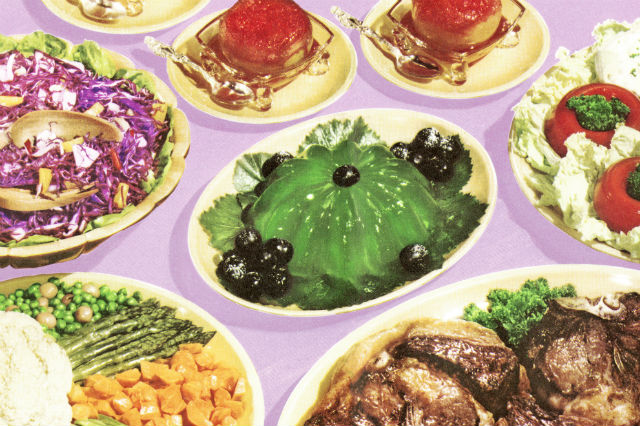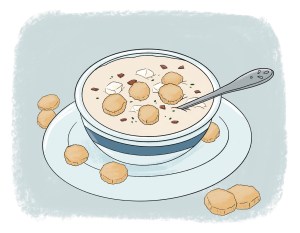Just like in fashion, there are food trends. In the fall, you pick up a pumpkin spice latte at your local coffee shop, but when December rolls around, it’s peppermint season. Healthy, organic and sustainable foods are “in,” while people are snubbing artificial ingredients and trans fats. All trends change with the times, and food is no different. Let’s take a walk down memory lane and explore the food fads of yesteryear.
1920s: Fruit Cocktail
There’s some speculation as to how the fruit cocktail was christened with its boozy title, but the name is more apt than you’d think. At the turn of the century, the sweet concoction was a mix of fruit, sugar and alcohol, usually a sweet wine or liqueur. When Prohibition hit in 1920, it became harder to add booze to the mix. Fruit cocktail was served at dinner parties or before a meal, sprinkled with powdered sugar or topped with marshmallows, a precursor to the fruit cocktail of the present.
1930s: Jell-O Salad
The Jell-O salad has stood the test of time, with pieces of floating food defying gravity in a fluorescent gelatin ring. When the Great Depression struck, it was vital for the American family not to waste leftovers from meals. When gelatin (a cheap form of protein) was prepared in a Jell-O mold with leftover vegetables, fruits, chicken and hard-boiled eggs – or anything else available – you had a new spin on a meal. The flavor combinations were endless, leading to some creative concoctions. Cottage cheese lime-pineapple salad anyone?
1940s: Spam
The popularity of spiced ham – or Spam – soared during World War II. The canned pork product was a filling source of protein to feed hungry soldiers and didn’t require refrigeration. According to the Smithsonian Institution, more than 150 million pounds of Spam were used during the war; soldiers even used its grease for lubricating their guns and waterproofing their boots. Housewives embraced the new product for its low cost, ease in the kitchen and versatility in recipes.
1950s: Outdoor Cookouts
The American cookout is just as popular today as it was in the 1950s. Families who had been rationing during the war emerged into a world of prosperity and craved relaxation … and meat. The iconic dome-shaped Weber grill made its debut in 1952, changing the game of cooking outdoors forever. Barbecue parties quickly became a familiar sight in suburban backyards. Gender roles shifted a little as grilling quickly became the specialty of the man of the house. Women still ruled over the kitchen, tending to salads, side dishes and desserts.
1960s: Instant Foods
In the 1960s, the key to the food world was convenience. Frozen foods and TV dinners quickly became all the rage for their timesaving capabilities. Boxed instant mashed potatoes, orange-flavored Tang and freeze-dried coffee were extremely popular for both their ease and the Space Age’s influence on pop culture. However, the age of cooking was not lost on the American family. Julia Child inspired housewives nationwide to try their hand at French cuisine at dinnertime, making an otherwise gourmet meal simple to replicate from the comfort of their kitchens.

1970s: Fondue
The melty pot of cheese that we’ve come to love may have a deep and hazy history, but it didn’t gain popularity in this country until the 1970s. At the 1964 New York World’s Fair, fondue was featured at the Swiss Pavilion’s Alpine restaurant. The Swiss Cheese Union created ad campaigns spotlighting Swiss men and women entertaining themselves over a hot pot of cheese fondue, and soon other advertisers followed suit. This food fad quickly caught on.
1980s: Nouvelle Cuisine
This trend acted as a revolution to the heavy and rigid cooking styles that French restaurant cuisine had embodied in the past. Nouvelle cuisine emphasized light tastes, fresh ingredients and clear flavors. When combined with an eye-pleasing presentation, it became an art form. This new cooking style spurred a worldwide social movement and inspired global changes in international cuisine. This food trend, still present and evolving today, eventually led to the fusion of cooking across cultures.
1990s: Fat-Free
With all the calorie-rich processed foods being marketed through the decades and the lower physical demand of daily jobs, Americans quickly realized that a change needed to be made to their daily eating habits. Studies were published urging people to improve their diets by cutting out fat, hence the fat-free food craze. While fat-free foods were often seen as healthy, they were often higher in sugar content and carbohydrates. The food trend was counterintuitive in reality, actually causing weight gain.
2000s: Cupcakes
Thanks to a scene featuring New York City’s Magnolia Bakery in the television comedy hit “Sex and the City,” a cupcake craze quickly swept the nation and specialty cupcake shops popped up in cities everywhere. Gourmet flavors were introduced to diversify the market, from sweet to savory. Food Network even aired a baking competition – “Cupcake Wars” – focused solely on cupcakes. Eventually, the cupcake’s reign came to an end, as it was dethroned by another food fad, the croissant-doughnut hybrid known as the cronut.
2010s: Bacon, Bacon and More Bacon
Those salty, crunchy pork strips that have dominated the breakfast table have quickly taken over pretty much every meal. Bacon can be wrapped around anything, going far beyond the cocktail party staple of bacon-wrapped scallops. This savory treat found its way into desserts after going through the candying process. It’s become a pop culture icon on T-shirts, bottled as a scent and even comes as a toothpaste flavor. Discover clothesline bacon.
Up-and-Coming Trends
America has seen plenty of food fads come and go. Remember the ramen burger? None of these food fads left us because they were bad, per se; they just reflected the times. Looking forward, it’s likely we’ll see eco-friendly improvements to packaging and the downfall of plastic straws. Meat grown in laboratories could gain a place as a more sustainable substitute for the traditional methods. Healthy eating will probably continue to dominate dinner tables. It’s hard to predict where we’re headed down the culinary road, but the greener hues on the horizon are clear, whether they’re garden-grown or planet-saving.
What was your favorite food fad? Does this list spark any memories? Share in the comments!
Hungry for more food stories? Your AAA has reviews, recipes and more to satisfy your cravings.
3 Thoughts on “Food Fads Through the Years”
Leave A Comment
Comments are subject to moderation and may or may not be published at the editor’s discretion. Only comments that are relevant to the article and add value to the Your AAA community will be considered. Comments may be edited for clarity and length.















1980s: frozen yogurt
60’s: Tang and Space Food Sticks!!
Those were great! You can still find tang if you look hard enough, but those space food sticks are hard to come by these days!